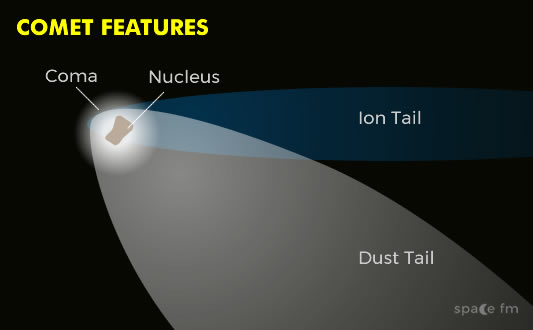Comets
11.2 - Understand the structure of comets (nucleus, coma and tails)Comets are ice and rock bodies. Typically their nucleus (the solid part) is no larger than an average asteroid.
As the comet approaches the sun, some water-ice evaporates and jets of gas and dust produce a spherical coma around the nucleus. The coma may be many times larger than the nucleus but is very thin, held by the comet’s very weak gravity.
The comet gets nearer to the sun and a tail forms in the opposite direction to the Sun. Really this is two tails. A curved dust tail forms and can be up to several millions of kilometres long. This tail forms because of radiation pressure from the Sun.
The dust tail is very bright to an observer because of the reflection of the ice particles from the Sun.
Particles from the solar wind hit the comet and an ion tail is produced which is more coloured but straighter than the dust tail.
Comets leave debris behind them. Some of this comes to Earth in the form of meteors.
Animation
Questions
- Label the parts A, B & C of the comet below.

- Explain why comets have two tails.
- In 2007 Comet 17P Holmes became larger than the Sun. Explain how this was possible.


.jpg)


 | © All Rights Reserved |
| © All Rights Reserved |